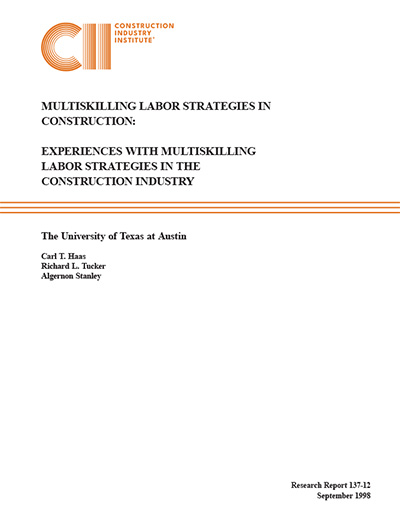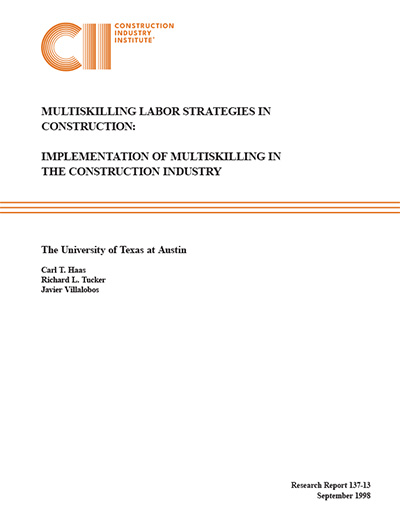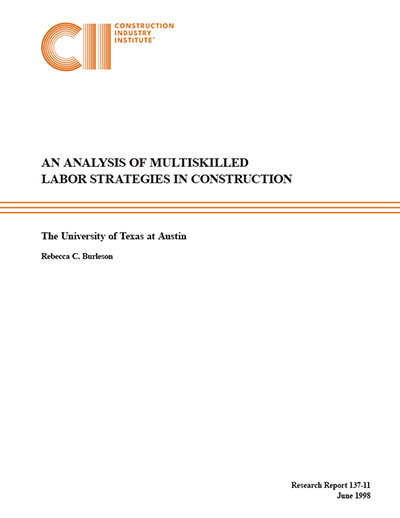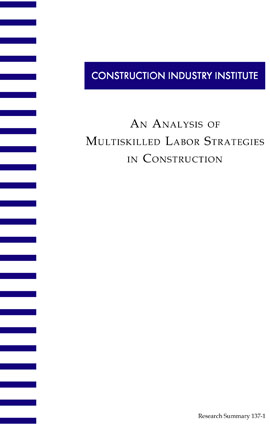
Multiskilling Labor Strategies in Construction: Experiences with Multiskilling Labor Strategies in the Construction Industry
Labor productivity, craft training, and the declining number of trade entrants into construction present critical challenges for our industry today. More flexible labor strategies may meet these challenges by improving project performance and better utilizing the current pool of skilled workers. One potential solution, already being used by some companies, may be multiskilling. Multiskilling is a labor utilization strategy where workers possess a range of skills appropriate for more than one work process and are used flexibly on a project or within an organization.
(A more complete definition of multiskilling is that it is a labor utilization strategy where workers possess a range of skills appropriate for more than one work process and are used flexibly on a project or within an organization. It is a managerial strategy based on developing competency within the workforce and the full utilization of these capabilities. Workers can be assigned to construction tasks based on their ability to perform the needed skill/task unrestricted by traditional job descriptions or work boundaries.
A multiskilled construction trade worker is an individual who possesses or acquires a range of skills and knowledge and applies them to work tasks that may fall outside the traditional boundaries of his or her original trade. In a construction context, this does not necessarily mean that a worker obtains or possesses mastery level skills in multiple trade areas. However, based on the flexible application of skills the worker already possesses or is willing to acquire, the worker can be an effective and productive contributor to the work output of several traditional trade disciplines.)
This study explored the application of multiskilled labor utilization strategies in construction and estimates the project impact of their use.
Research efforts focused on: (1) determining the extent of multiskilling use in the construction industry, (2) identifying opportunities for the use of multiskilling, (3) developing an economic equation to model the cost benefits of multiskilling, (4) assessing the effect of multiskilling on worker and project, and (5) assessing barriers to the use of multiskilling. The scope of the study included a detailed project level analysis of a hypothetical, domestic, grass-roots, open shop, direct hire, industrial construction project. It also included analysis of existing multiskilling applications in construction via surveys and other techniques. The study used traditionally accepted trade delineations to form the “multiskills” used in the analysis. Also, productivity data/analysis techniques including (1) cost projections based on crew productivity and average worker-hour costs, and (2) scheduling tools which allow resource allocation and overhead costs analysis, were used to estimate the project impact.
Benefits of multiskilled labor utilization were observed with regard to total project labor cost, employment opportunities for construction workers, and other industry labor issues. These benefits included conservative estimates of 5% or more total labor cost savings, a potential 35% reduction in required project workforce, a potential 47% increase in average employment duration, and an increase in wage/annual earning potential for multiskilled construction workers. Productivity improvements were reported by over 75% of those surveyed in the study.
The most successful multiskilling strategy assessed in this analysis was one which identified four multiskilled crafts groupings. The four multiskilled crafts included civil, electrical, mechanical and a general support craft which included all craft helpers. This strategy may also offer additional benefits with respect to multiskilling implementation, craft recruiting and retention, and craft training. The data was supported by results of the practice surveys of existing construction multiskilling applications conducted as part of this research. The distribution of projects included in the current multiskilling practice surveys indicates that multiskilling is a viable labor strategy in both union and non-union environments.
A review of managerial and economic multiskilling results from manufacturing applications also indicated that multiskilling strategies provide increased opportunities for the development of process innovations and technology implementation. It is believed that multiskilling strategies may provide a breakthrough in construction labor utilization that leads to many other industry advancements.
Impediments to effective multiskilling are both fundamental and practical. Fundamental impediments are more difficult to overcome and include limits on human skill retention and the complexity of maintaining a multiskilled workforce from management and human capital investment perspectives. Practical impediments include owner bid requirements, project management infrastructure, resistance to change, and licensing requirements among others. Nevertheless multiskilling is already being used by some major industry participants as a strategic business advantage. It remains for further research to determine where the best opportunities for multiskilling exist, how to identify them, and how to implement multiskilling most effectively.
The research efforts were conducted in three separate phases. Phase I investigated experiences with multiskilling in the construction industry to determine actual and perceived benefits, impediments, and limitations to the use of multiskilled labor strategies. Phase II included the project level analysis of different multiskilled strategies. Phase III involved determining key issues that must be addressed in the implementation of a multiskilling program. This research report focuses on Phase III of the research and discusses the implementation of multiskilling in the construction industry.
Five major impediments that need to be addressed during the program design phase are listed below, with details for each included in the research findings. (RR137-12, p. 55)
- Worker resistance
- Owner requirements
- Licensing requirements
- Training issues
- Cost issues



